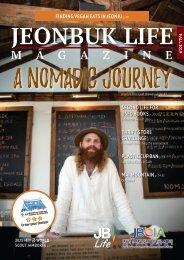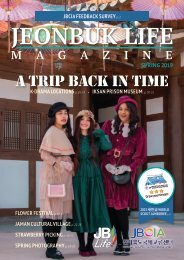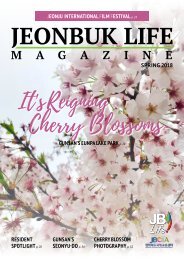2019 JB LIFE! Magazine Winter Edition
Create successful ePaper yourself
Turn your PDF publications into a flip-book with our unique Google optimized e-Paper software.
view nature from the inside,
while letting in the warmth of
the sun, making the space cozy
and inviting. “Our windows and
doors stand as 'frames for the
scenery,'” Ms. Park says, “You
can see the cobblestone road,
yellow ginkgo trees outside
during Fall, and gleaming
white snow in Winter. I decided
on the name of the cafe in
the hope that you will enjoy
it according to time, weather,
season and mind.”
The walls of the cafe are
decorated with artwork from
local artists. One in particular
is a wooden installation
by Park Kyung Sik, who is
famous for creating scenes
using abandoned branches
in the wild.
The cafe’s specialty includes
traditional teas, and they
use only Korean jujube and
all their offerings are free
of preservatives. Alongside
the tea or coffee, they serve
Korean desserts in red bean,
black bean paste, pumpkin,
and blueberry flavors.
For Ms. Park, it is important that
the legacy and appreciation
for the Hanok continues. “The
younger generation seems
to have some preconceived
notions that traditional
Korean houses are old and
uncomfortable. I felt very sorry
for this. The hanok may be old,
but I wanted to show you that it
can be modern and felt new by
saving its beautiful elements.”
From the outside the Hanok
(traditional Korean House)
design stands proudly to greet
its guests, with its signature
tiled roofs and wooden
structures, depicting a calm,
safe, shelter that perfectly
blends in nature. Cafe Cha
Gyeong, which opened early
October in 2019, is designed
to embody the spirit of the
Hanok and transporting
its guests to its golden
period of time. “Cha Gyeong
literally means ‘borrowing a
landscape’ by combining the
meaning of ‘borrowing a car’
and ‘gyeonggyeong,’" explains
the owner Park Da Ah (박다아).
traditional beauty of Hanok
to life.” According to Culture
Trip, the Hanok’s design took
into account the changing of
the seasons: “The overhang of
the roof is specially designed
to prevent the sunlight in the
summer from entering the
interior of the Hanok, thus
keeping it cool in the blistering
heat. During the bitter winter
months, because of the angle
of the overhang and the lower
sun, the sunlight can penetrate
a part of the interior to provide
heat to its occupants and, by
doing so, decrease the amount
of fuel needed to heat the
Hanok.”
The Hanok design plays
a significant role in the
cafe’s mission to “bring the
This can be seen and felt
in the cafe, where the open
windows allow customers to
49















